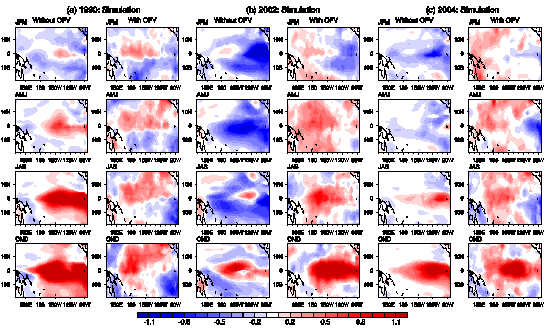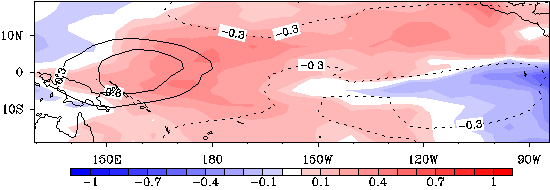An optimal forcing vector (OFV) approach is proposed. The OFV offsets tendency errors and optimizes the agreement of the model simulation with observation. We apply the OFV approach to the well-known Zebiak-Cane model and simulate several observed eastern Pacific (EP) El Niño and central Pacific (CP) El Niño events during 1980-2004, in attempt to identify the error source that limits the ability of model simulating the El Nino events. The study has been published in Climate Dynamics; the lead author is Dr. Duan Wansuo and coauthors are Ph.D student Tian Ben and Dr. Xu Hui, all of whom are at LASG.
We demonstrate that the Zebiak-Cane model with a proper initial condition often reproduces the EP-El Niño events; however, the Zebiak-Cane model fails to reproduce the CP-El Niño events. The model may be much more influenced by model errors when simulating the CP-El Nino events. As expected, when we use the OFV to correct the Zebiak-Cane model, the model reproduces the three CP-El Niño events well. Furthermore, the simulations of the corresponding winds and thermocline depths are also acceptable. In particular, the thermocline depth simulations for the three CP-El Niño events lead us to believe that the discharge process of the equatorial heat content associated with the CP-El Niño is not efficient and emphasizes the role of the zonal advection in the development of the CP-El Nino events.

Figure: The SST anomaly component of the seasonal evolutions of the (a) 1990, (b) 2002, and (c) 2004 CP-El Nino events simulated by the Zebiak-Cane model with and without the OFVs, respectively. The former cannot produce the CP-El Nino events due to effect of model errors; while the latter reproduce the CP-El Nino events because the OFVs offset the effect of model errors.
The OFVs associated with the three CP-El Niño events often exhibit a sea surface temperature anomaly (SSTA) tendency with positive anomalies in the equatorial eastern Pacific; therefore, the SST tendency errors occurring in the equatorial eastern Pacific may dominate the uncertainties of the Zebiak-Cane model while simulating CP-El Nino events. A further investigation demonstrates that one of the model errors offset by the OFVs is of a pattern similar to the SST cold-tongue cooling mode, which may then provide one of the climatological conditions for the frequent occurrence of CP-El Nino events. The OFV may therefore be a useful tool for correcting forecast models and then for helping improve the forecast skill of the models.

Figure: The differences in the SST anomaly field (shaded) and the differences in zonal wind anomaly field (black contours) between the model simulations with and without the OFV (the former minus the latter). The growth-phase periods of three CP-El Nino years, a total of 36 months, are considered.
More information at:
http://link.springer.com/article/10.1007%2Fs00382-013-1993-4
